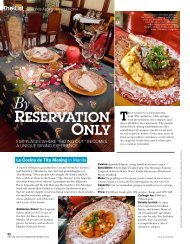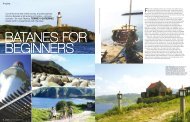Santa Ana
Santa Ana
Santa Ana
You also want an ePaper? Increase the reach of your titles
YUMPU automatically turns print PDFs into web optimized ePapers that Google loves.
Local<br />
Dawn<br />
Awakening in<br />
<strong>Santa</strong> <strong>Ana</strong><br />
The slow life in a small coastal town in northeastern<br />
Philippines charmed city-slicker Laya Lantano<br />
There is unrivaled anticipation in going someplace new, I<br />
thought, at the start of my 16-hour bus ride from Manila<br />
to the northeastern edge of the Philippines. But the<br />
torturous trip inside a moving ice machine tested my sanity as<br />
the hours slowly crept forward, making me more anxious than<br />
fascinated. I traveled far to discover the beauty of my country,<br />
and now I was being treated to endless vistas of green fields and<br />
cloudless skies. After 630 kilometers, four provinces, numerous<br />
pitstops, and a set of sore shivering muscles, I at last reached<br />
my destination.<br />
<strong>Santa</strong> <strong>Ana</strong> in Cagayan is a 444-square-kilometer town that<br />
sits calmly on the rim of the Philippine Sea. The province is<br />
part of the Cagayan Valley region which also includes Batanes,<br />
Isabela, Nueva Vizcaya, and Quirino. <strong>Santa</strong> <strong>Ana</strong>’s sheer<br />
loveliness, wrapped by the Sierra Madre mountain range,<br />
the longest chain of mountains in the Philippines that starts<br />
in Cagayan and ends in the southeastern Luzon province of<br />
Quezon, made me feel like I was worlds away. On hindsight,<br />
I was pleased that it took close to a day to get there, for this<br />
assured me that its soul had not yet been corrupted by city life.<br />
We were just in time for the annual Viray Festival,<br />
a celebration of the coming of immigrant settlers<br />
centuries ago from the nearby Ilocos region via wooden boats<br />
called viray. This may explain why majority of the townsfolk<br />
speak the Ilocano language, as well as other indigenous<br />
dialects. The mayor’s wife Pinky Rodriguez—fondly called<br />
Mayora by the locals—started the festivity four years ago. She<br />
jests, “para naman magkaroon ng kasiyahan sa bayan namin!”<br />
(so the town will have something to amuse itself).<br />
Under the sweltering heat of the noonday sun, adorable<br />
children in makeshift props and costumes pranced barefoot<br />
on the dusty sand. The ones living near the coast had waited<br />
for low tide to build sandcastles for the night’s competition.<br />
As the sky turned dark, local dancers took to the stage with<br />
breakdancing and, quite interestingly, firedancing.<br />
Cagayan province is a land of rugged coastal mountains,<br />
hidden coves, and solitary islands. Its unspoilt charm will<br />
entrance the adventurous traveler: the pristine blue waters and<br />
fine golden-sand beaches of Anguib Cove, also called Golden<br />
Beach and touted by some as the Boracay of the north, and the<br />
recesses of the Gotam Mangroves.<br />
In the town of <strong>Santa</strong> <strong>Ana</strong>, the idle pace of countryside life<br />
proved therapeutic. I woke up very early the following day<br />
when the only ones up were the boy peddling hot pandesal and<br />
56<br />
travelife SePteMBer-OCtOBer 2008 www.travelife.biz<br />
PHOTOGRAPHED BY NICKY SERING<br />
(Clockwise from top left) The Faro de<br />
Cabo Engaño lighthouse on Palani<br />
Island stands 100 meters above sea<br />
level. Midway up is an open deck that<br />
looks out to a 360-degree panorama<br />
of <strong>Santa</strong> <strong>Ana</strong>’s rural paradise; for a<br />
coastal town like <strong>Santa</strong> <strong>Ana</strong>, lobsters<br />
are a mainstay in every meal; adorable<br />
children in makeshift props and<br />
costumes perform under the sweltering<br />
noonday sun; the placid waters of<br />
Anguib Cove. (Opposite page) In <strong>Santa</strong><br />
<strong>Ana</strong>, there’s nothing quite like a tranquil<br />
sail around the edge of the Philippines<br />
57<br />
www.travelife.biz SePteMBer-OCtOBer 2008 travelife
Local<br />
The Cape Engaño lighthouse looks out to the Dos<br />
Hermanas Islands on the east. (Above right) Young ladies<br />
dancing. (Right) Carts decorated with local produce<br />
cicadas thrumming in the dark. I headed<br />
to the port because the locals had advised<br />
me to take a 15-minute sail from the<br />
mainland to Crocodile Island, where the<br />
sunrise is reportedly at its best.<br />
Sitting on the limestone shards of<br />
Crocodile Island (so named because<br />
of its shape and not for anything else),<br />
staring out into the glimmering open<br />
sea as purple streaks of sun peek past<br />
the oranged-tainted clouds above<br />
me—it’s pure bliss. Indeed, embracing<br />
the ephemeral is a unique experience,<br />
something that hardly comes by to<br />
someone who grew up in the city.<br />
When the sun came up, we sailed to Palaui, another<br />
island farther northeast. After docking at Punta Verde,<br />
we spent an hour trailblazing into the thick woods with our<br />
Agta guide, ocassionally resting on spots of grassland. After<br />
30 minutes of hiking up the slope with only the faint chorus<br />
of waves and our labored breathing breaking the silence, we<br />
reached the peak with its majestic lighthouse and magnificent<br />
view of the Philippine Sea below.<br />
Built on December 21, 1862, the 100-meter-high Faro de<br />
Cabo Engaño or Cape Engaño lighthouse has suffered from<br />
years of neglect. With collapsing beams, distressed floors, a<br />
dilapidated roof, and a cracked wall where the stolen marker<br />
used to be, it’s not surprising that the lighthouse compound<br />
has a general depressing feel to it. Yet as I ascended its rusty<br />
spiral staircase, stopping at the padlocked route up the<br />
lightbeams, the atmosphere shifted. The bare deck of open<br />
windows offered a refreshing 360-degree view of paradise:<br />
battering waves to the north and west, the Dos Hermanas<br />
islands to the east, and the hilly terrain to the south.<br />
The air is thin at this altitude and I couldn’t help but<br />
wax philosophical. Perhaps there’s a reason my trip to <strong>Santa</strong><br />
<strong>Ana</strong> ended with this visit to Cape Engaño lighthouse, where I<br />
literally stood on the edge of the Philippines. Atop a fortress<br />
of rugged abandonment, I gaze out into the open, and the<br />
glittering sea makes me feel hope. For a traveler on a quest to<br />
find life, this has led me closer to my destination. n<br />
58<br />
travelife SePteMBer-OCtOBer 2008 www.travelife.biz<br />
NAviGATe yourSelF:<br />
SANTA ANA, CAGAyAN<br />
NeeD To KNoW<br />
The municipality of <strong>Santa</strong> <strong>Ana</strong> hosts part of the 55,000-hectare<br />
Cagayan Special Economic Zone in Region 2. Since 1997, the freeport<br />
zone, independently managed by the Cagayan<br />
Economic Zone Authority or CEZA, targets<br />
investments from neighboring Southeast Asian<br />
countries. The industrial city of Kaoshiung<br />
in Taiwan is only a 45-minute plane ride<br />
away and is actually a few kilomters closer<br />
to <strong>Santa</strong> <strong>Ana</strong> than Manila. Locals can tune in<br />
to Taiwanese radio programs because of the<br />
proximity. Today, more than a transshipment<br />
hub, the economic zone is the site of two<br />
casino resorts, Sun City and Eastern Hawaii,<br />
exclusively for foreign investors and visitors. An<br />
airport is also in the works.<br />
TrAveler’S CheCKliST<br />
Phone area code: 78<br />
Commonly spoken languages: Ilocano,<br />
Tagalog, English, Ibanag<br />
Travel time from Manila: 16 hours<br />
by road, an hour by plane to the provincial<br />
capital, Tuguegarao City<br />
hoW To GeT There<br />
By bus: Victory Liner (EDSA Kamias), Baliuag Transit (EDSA Cubao),<br />
and Delta (Blumentritt) buslines ply the Manila-Tuguegarao route daily.<br />
The Florida Bus (Sampaloc, Manila) goes straight to <strong>Santa</strong> <strong>Ana</strong>.<br />
By plane: Air Philippines flies to Tuguegarao three times weekly, while<br />
Cebu Pacific flies daily. From Tuguegarao, a van or minibus can take<br />
you to <strong>Santa</strong> <strong>Ana</strong>. For recommended tour packages, try Lakbay.Net, tel<br />
(2) 517-6655, e-mail travelife@lakbay.net.ph<br />
By private vehicle: Drive along the North Luzon Expressway and<br />
exit at the San Miguel, Bulacan tollgate. Go straight down the national<br />
road, passing several towns in Nueva Ecija, Nueva Vizcaya, and<br />
Isabela. When you reach the junction in Santiago City, Isabela, turn left<br />
and drive up to the province of Cagayan Valley. <strong>Santa</strong> <strong>Ana</strong> follows the<br />
town of Gonzaga.<br />
Bancas (motorized outrigger boats) docked on the Barangay San<br />
Vicente port cruise the nearby islands and coves for local commuters.<br />
You can hire the whole boat at posted rates.<br />
WheN To Go<br />
The summer months of March-June are the best times to go. If traveling<br />
by road, schedule your trip so you leave Manila at night and arrive<br />
in <strong>Santa</strong> <strong>Ana</strong> by morning. The first two weeks of June are also ideal<br />
because the Viray Festival happens on June 8, while fishing enthusiasts<br />
will love the game fishing tournaments held yearly. Check www.pgff.org<br />
for schedules<br />
WhAT To BriNG<br />
• resort wear: shorts, tank tops, T-shirts, swimsuits, flip-flops, sandals<br />
• Fishing equipment for those who want to fish<br />
• Camera and batteries<br />
• Cash<br />
WhAT To Do<br />
• Try water sports. <strong>Santa</strong> <strong>Ana</strong> and nearby islands like Palaui are<br />
ideal for game fishing, snorkeling, and scuba diving because of its rich<br />
marine resources. There are also beaches ideal for swimming or picnics.<br />
• Go hiking and catch up on history. The Punta Engaño<br />
Lighthouse on Palaui Island is the only working lighthouse in the<br />
northeastern coast of the Philippines and provides fantastic vistas of<br />
the Philippine Sea. Palaui island is also an ideal spot to go trekking or<br />
hiking.<br />
• Try local delicacies like the batil patong,<br />
a hearty noodle dish cooked with pork liver<br />
and ground beef, topped with poached egg<br />
and served with a bowl of clear soup. On<br />
the way back to Manila, stop by the town of<br />
Alcala along the national highway for a bag of<br />
Teaño carabao’s milk. The storeowner is used to<br />
commuters knocking in the middle of the night for<br />
an order. And while you’re at it, have a taste of<br />
the longganisa from Tuguegarao City.<br />
As the locals danced,<br />
every step becomes<br />
a declaration of a<br />
town that is slowly<br />
rising from the fringes<br />
of development<br />
Where To STAy<br />
Jotay’s Beach resort is a decent beachfront<br />
property owned by a British national and his<br />
Filipina wife. It has air-conditioned rooms, basic<br />
facilities, and options for water activities such<br />
as snorkeling and sailing. For inquiries and<br />
reservations, call (+63906) 478-1270, (+63915)<br />
210-2058, (+6378) 858-1026, or go to www.<br />
jotayresort.com. For homestays, contact the<br />
municipal tourism office at (+63929) 365-9409.





